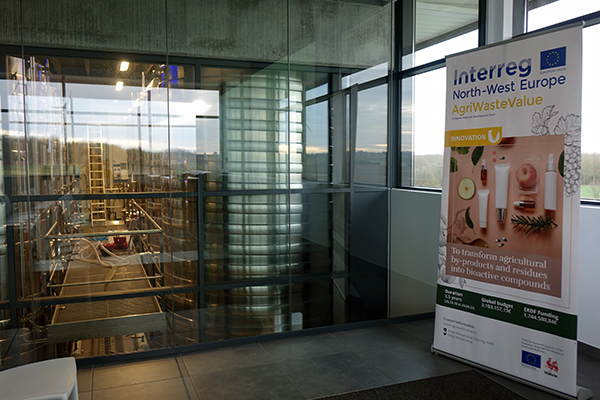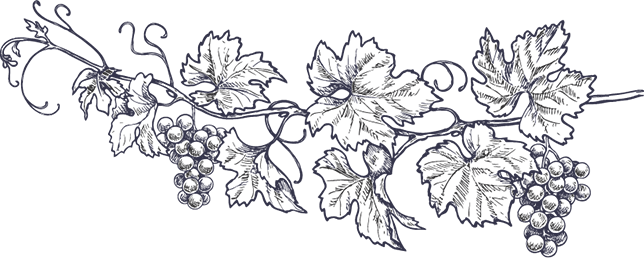
AgriWasteValue mid-term event : report on project progress, halfway through
27.01.2021The AgriWasteValue mid-term event was held on Tuesday, January 26, 2021, online, during NutrEvent Digital, the European meeting place for innovation in food, feed, nutrition and health. More than 120 people registered to this event, most of them specialists of the different fields (cosmetics, nutraceutics, chemistry, energy and agriculture) concerned by the project. Many academics were also registered.
The AgriWasteValue project
The event started by a presentation of the project, by Clémence Rotolo, from AgroParisTech Innovation (France). The AgriWasteValue project is part of the Interreg North-West Europe programme, which is a European research programme fostering transnational cooperation to make Northwestern Europe a key economic player and an attractive place to work and live, with high levels of innovation, sustainability and cohesion. This project has for starting point the growing demand for consumers to return to more natural products, especially in cosmetics and nutraceuticals. These natural products are currently exported in Europe while a lot of biomass is actually available here, in North-West Europe! This is why 9 partners (AgroParisTech Innovation, Celabor, Cosmetic Valley, Delphy, EPFL, Eurasanté, PFI, University of Reims Champagne-Ardenne and ValBiom) from 5 countries (France, Belgium, Netherlands, Germany and Switzerland) are going to work together for 3.5 years (October 2018 – April 2022).
The AgriWasteValue project aims to transform agricultural by-products and residues from the European North-West regions into bioactive compounds in order to use them in key industrial sectors such as the cosmetic and nutraceutical fields, and then, in a second phase, in the energy, chemical and agricultural sectors.
How does it work exactly?
Steps:
- Production of bioactives via extraction
- Biochemical treatment (also called fermentation) transforming lignocellulosic fractions into biosolvents and biobased chemicals
- Production of biogas and fertilizer with the final residues
The final goal is to get to a new circular economy by using the woody part of the by-products and transforming it into new bioactive molecules. 3 different biomasses will be used for this research: vines (3 000 000 hectares in Europe), apple trees (470 000 ha) and pear trees (100 000 ha).
Results halfway through the project
Inventory, selection, collection and pretreatment of starting agricultural wastes-sourcing
In order to develop the cascading valorization chain of agriwaste biomass, it is necessary to clearly identify the wastestream available in the North West region. A specific attention is paid to agriwaste sidestreams from sources such as vineyards, orchards, tree nurseries and more. Old wine wood, buds from trees and bark trees have been already identified as promising agriwastes for the considered valorization chain as sources of bio-active agents.
Data collection is a complicated task. The sidestreams collected are mapped and analyzed by the partners Delphy and ValBiom (https://www.agriwastevalue.eu/en/raw-material). To this day, 487 locations (sources of agriwastes from vineyards, orchards, tree nurseries, etc.) were added to the digital map: 460 in Belgium, 20 in Netherlands and 6 in France. Data collection is still an on-going task.
A selection of the most promising agriwastes were realized according to the following aspects: seasonability - available amounts - economical aspects. The selected agriwastes were collected from local producers by R&D partners to start the next activities of the project (implementation of the cascading valorization chain and market applications):
- Celabor collected 12 different samples of grapes, 9 of them being new collection (2020) whereas the other 3 samples were collection in the same fields as last year (2019) in order to perform repeatability studies. Celabor also performed safety profile analysis (mainly analysis of heavy metals) on samples sent by PFI, Delphy, ValBiom and AgroParisTech Innovation.
- PFI collected samples (apple varieties) from the 2020 cutting season. These samples were collected from the same fruit farmer as in 2019 in order to compare both years regarding the content of bioactives.
- ValBiom performed a second sampling collection campaign. Samples from the three biomasses (apple tree, pear tree and vine) were collected in Wallonia in order to identify possible annual variations between samples and extracts.
- For Switzerland, l’Ecole Polytechnique Fédérale de Lausanne (EPFL) collected data from fruit statistics (2018) for different cantons. With the availability of the percentage area for these fruit cultivation, the biomass potential for these fruits waste was calculated.
Implementation of the cascading valorization chain
Celabor’s activities showed that ethanol was the most interesting solvent to recover molecules of interest. In 2020, the selected solvent (ethanol) was applied to three different extraction methods:
- Accelerated Solvent Extraction (ASE, eco-friendly method);
- Ultrasound Assisted Extraction (UAE, eco-friendly extraction);
- Maceration (conventional method of extraction).
The results were compared in terms of extraction yield, total phenolic content and biological activities. For grape, pear and apple residues, ASE appeared to be the most promising extraction method.
The residual biomasses remaining after extraction were sent to PFI for further investigations in line with the project scope (implementation of a cascading valorization chain).
Besides extraction and biological evaluation, a high-throughput analysis of bioactive polyphenolic from all samples were performed by Celabor. Major bioactive metabolites composing each variety were determined (such as resveratrol, phlorizin, catechin, epicatechin, etc). All these molecules are known as hit antioxidant component in food and cosmetic industries. All data were sent to EPFL to perform cost and LCA analysis.
University of Reims Champagne-Ardenne (URCA) is finishing the development of a workflow (AMIDE) combining fractionation methods to obtain a rapid chemotyping of agriwastes extracts. The next step will consist of the virtual screening of molecules on Toxoplasma gondii.
Jointly with Celabor, AgroParisTech Innovation identified an interesting molecule in apple wood extracts. The PhD student synthesized around twenty analogs of this molecule to identify interesting cosmetic properties. This work will soon be published (end of 2020). The PhD student also developed a methodology for the enzymatic functionalization of molecules in order to modulate their physico-chemical properties. First results are encouraging and when the process will be optimized, it will be possible to transpose this on plant extracts provided by Celabor.
PFI focused on the optimization of the thermochemical treatment with the extracted biomass (apple tree, pear tree, grape) from Celabor. PFI mixed the three extracted biomasses to one so called “mixed sample”. Different pretreatment temperatures and duration times were tested. Results were compared with a mixed sample of the unextracted biomass. Then PFI hydrolyzed all solid samples by cellulolytic enzymes to investigate the effect of the different treatment conditions on the glucose yield after the enzymatic hydrolysis. Investigations will continue until the end of the next period during which results will be presented.
More information
- Replay of the mid-term event
- Presentations of the mid-term event
- Presentation of the Interreg NWE programme and of AgriWasteValue
- Biomass from orchards and vineyards: from extraction raw materials to fertilizers
- Recovery and enzymatic modification of bioactive metabolites from agricultural residues using green technologies: methodologies and processes
- Bio-based chemicals and energy from agro-residues
- Agro-residues for feeding the Green Economy: framework conditions and implications
- Why and how to develop premium beauty & health ingredients from waste & biomass
- Cosmetic sector : the place of plants and naturalness
- A question ? Contact : info@agriwastevalue.eu
